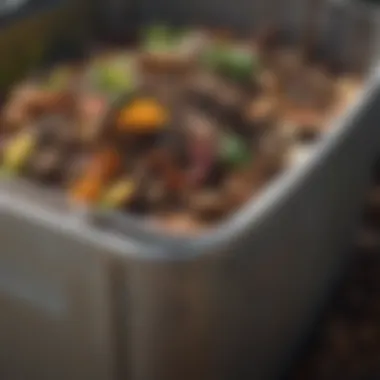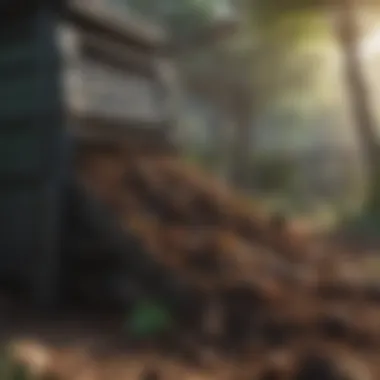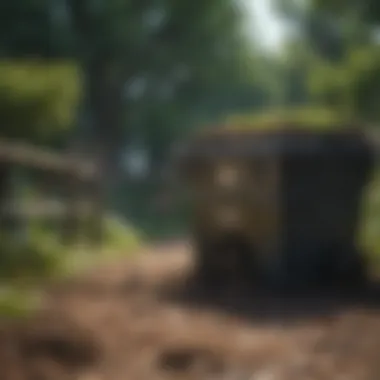A Beginner's Guide to Starting Your Compost Bin: Step-by-Step Instructions


How to Kickstart Your Compost Bin
Are you ready to embark on a journey towards sustainability right at your doorstep? Starting your compost bin is not only environmentally-friendly but also a rewarding endeavor that promotes a healthier ecosystem. This comprehensive guide will equip you with the knowledge and tools needed to kickstart your composting journey successfully.
Finding the Perfect Spot
When diving into the world of composting, the first crucial step is choosing the ideal location for your compost bin. Opt for an area that receives a good balance of sunlight and shade, promoting the decomposition process while preventing the compost from drying out. Furthermore, ensure the spot is easily accessible for regular maintenance and turning of the compost pile.
Key points to consider:
- Sunlight and shade balance
- Accessibility for maintenance
- Proximity to your kitchen garden
Subsection: Unleashing the Benefits
Composting not only reduces kitchen waste but also enriches the soil, leading to healthier plants and crops in your garden.
Selecting the Right Bin
The next crucial step in your composting journey is selecting the appropriate bin. Whether you opt for a traditional compost bin or a more contemporary compost tumbler, choose a size that suits your household's waste production. Additionally, ensure the bin has proper ventilation to facilitate the composting process and prevent unpleasant odors.
Considerations when selecting a bin:
- Size and capacity
- Ventilation features
- Aesthetics and space utilization
Subsection: Navigating Potential Issues
Improper ventilation and excess moisture can lead to a smelly compost bin. Regularly turning the compost pile and adding dry material can help combat these issues.
Initiating the Composting Process
With the location and bin in place, it's time to begin the composting process. Start by adding a layer of brown (carbon-rich) material, such as dried leaves or newspaper shreds, followed by green (nitrogen-rich) kitchen scraps. Remember to maintain a balanced ratio of brown and green materials to facilitate decomposition efficiently.
Steps to initiate composting:
- Layering brown and green materials
- Turning the compost pile regularly
- Monitoring moisture levels
Subsection: Maximizing Compost Quality


Regularly aerating the compost pile and avoiding meat and dairy products can help maintain a high-quality compost for your gardens.
Troubleshooting Common Challenges
As you dive deeper into composting, you may encounter common challenges such as foul odors, slow decomposition, or pests. Understanding how to address these issues promptly is crucial to maintaining a healthy and productive compost bin.
Common challenges and solutions:
- Foul odors: Add more brown materials and ensure proper aeration
- Slow decomposition: Increase turning frequency and adjust brown-green ratio
- Pests: Secure the bin lid and avoid adding oily or greasy food waste
By following these steps and guidelines, you are well on your way to nurturing a thriving compost bin that not only reduces waste but also enriches your surroundings with nutrient-rich soil. Embrace the journey of composting and witness the transformative impact it brings to your sustainable lifestyle!
Sources: Wikipedia, Britannica
Preamble
Composting, a practice as ancient as agriculture itself, holds the key to sustainable waste management and soil enrichment. In this article, we delve into the realm of composting, illuminating the path for beginners to embark on this eco-friendly journey.
Understanding Composting
Composting represents nature's way of recycling organic matter, transforming kitchen scraps and yard waste into nutrient-rich humus. The benefits of composting extend beyond waste reduction; they encompass soil nourishment, reduced carbon footprint, and fostering a deeper connection with the environment.
Setting Up Your Compost Bin
Embarking on your composting journey entails selecting an ideal location where sunlight and drainage converge harmoniously. The choice of the right compost bin becomes crucial, determining the efficiency of the composting process. The initial ingredients you introduce to your bin lay the foundation for successful decomposition.
Maintaining Your Compost Bin
Aeration and moisture levels within the compost pile dictate the speed and quality of decomposition. Regularly turning the compost ensures aeration and homogenous breakdown. Monitoring parameters like temperature and odor provides insights into the health of the compost, guiding adjustments when necessary.
Troubleshooting Common Issues
Despite its simplicity, composting may encounter hurdles along the way. Odor problems often arise due to poor aeration or excess moisture, requiring strategic interventions. Pest infestations can disrupt the compost ecosystem, necessitating barrier methods or natural remedies. Addressing slow decomposition calls for a reassessment of the compost mix to restore optimal conditions.
End
As we conclude our exploration of starting a compost bin, we emphasize the transformative power of composting in fostering sustainability. From grassroots waste reduction to nurturing thriving gardens, composting stands as a testament to humanity's ability to coexist harmoniously with nature.


Understanding Composting
Composting is an invaluable practice essential for sustainable living. Its significance lies in the efficient decomposition of organic matter, transforming waste into nutrient-rich soil amendment that benefits plants. Emphasizing a circular approach to resource management, composting minimizes landfill waste and reduces greenhouse gas emissions, contributing to a healthier environment. Understanding the intricacies of composting aids individuals in adopting eco-friendly habits that resonate with the current emphasis on environmental stewardship.
What is Composting?
Composting is a natural process where organic materials like fruit peels, grass clippings, and leaves decompose into a dark, crumbly substance known as compost. This nutrient-rich end product serves as a powerful fertilizer, enriching the soil with essential nutrients and promoting plant growth. Composting can occur through aerobic or anaerobic processes, with the former being the most common method due to its quicker decomposition rate and minimal odors.
Benefits of Composting
The benefits of composting extend far beyond environmentally conscious waste disposal. Compost enriches soil structure, improving water retention and aeration essential for healthy plant growth. By incorporating compost into gardens or agricultural fields, individuals can reduce reliance on chemical fertilizers, thereby decreasing environmental pollution and promoting sustainable agricultural practices. Additionally, composting helps sequester carbon in the soil, contributing to mitigating climate change by capturing and storing atmospheric carbon dioxide.
Setting Up Your Compost Bin
Setting up your compost bin is a fundamental step in embracing sustainable practices. The proper establishment of this crucial component sets the groundwork for successful composting endeavors. By diligently following the right procedures, you pave the way for nutrient-rich soil amendment that benefits both your plants and the environment.
When it comes to setting up your compost bin, several key aspects merit consideration. First and foremost, selecting an appropriate location lays the foundation for effective composting. Choosing a spot that receives adequate sunlight and drainage is imperative for the decomposition process to thrive. Furthermore, the accessibility of the location also plays a vital role in ensuring regular maintenance and monitoring. A well-positioned compost bin not only enhances functionality but also blends seamlessly into your outdoor space.
In addition to location, the type of bin you select significantly impacts the composting experience. From worm bins to tumblers, each container offers unique advantages based on your individual requirements. Factors such as bin size, ventilation, and insulation must be taken into account to facilitate optimal decomposition. The right bin not only accelerates the composting process but also prevents potential issues such as odors and pests.
Once you have chosen the perfect bin and location, it is time to add the first ingredients. Plant matter such as kitchen scraps, yard waste, and shredded paper serve as the initial layers of your compost pile. Balancing carbon-rich (browns) and nitrogen-rich (greens) materials is essential for creating a healthy compost ecosystem. A well-mixed and aerated pile kickstarts the decomposition process, setting the stage for nutrient-rich humus production. Establishing this foundation properly ensures a smooth composting journey with minimal disruptions.
Selecting a Location
When deciding on the location for your compost bin, consider environmental factors that contribute to successful composting. Ideally, choose a site that receives a good amount of sunlight throughout the day while also being well-drained. Direct exposure to sunlight aids in maintaining optimal temperature levels within the compost, facilitating faster decomposition. Proper drainage prevents waterlogging, ensuring aerated conditions necessary for microbial activity. Additionally, proximity to a water source simplifies the task of watering the compost pile when needed, fostering a healthy composting environment.
Choosing the Right Bin
Selecting the right compost bin is a critical decision that influences the efficiency and convenience of your composting process. Various types of bins are available, each offering distinct advantages based on your requirements. From traditional plastic bins to innovative tumblers, the market presents a plethora of options catering to different preferences. Consider factors such as size, portability, and ventilation when choosing a bin to ensure it aligns with your composting goals.
Adding the First Ingredients
Initiating your compost pile with the first ingredients marks the commencement of the composting journey. Kitchen scraps, yard waste, and shredded paper form the initial layers of organic matter essential for decomposition. Maintaining a proper balance between carbon-rich and nitrogen-rich materials is crucial for efficient composting. Layering these materials strategically creates a harmonious environment that supports microbial activity, leading to the transformation of organic waste into nutrient-rich compost. Remember, a well-formulated mix of ingredients sets the stage for a successful composting experience.
Maintaining Your Compost Bin
Maintaining your compost bin is a crucial aspect that ensures the success of your composting process. It involves a series of necessary steps to create the ideal environment for decomposition and nutrient-rich compost production. Adequate maintenance not only accelerates the decomposition process but also prevents any potential issues that may arise during composting. This section will delve into key elements and benefits associated with maintaining your compost bin.


Aeration and Moisture
Aeration and moisture play pivotal roles in maintaining a healthy compost pile. Proper aeration allows oxygen to reach the microorganisms responsible for breaking down organic matter, facilitating the decomposition process. On the other hand, maintaining optimal moisture levels is vital for microbial activity and ensures that the compost remains moist but not waterlogged. Strike a balance between aeration and moisture to promote efficient decomposition and prevent unpleasant odors.
Turning the Compost
Turning the compost is an essential practice that promotes even decomposition and prevents the formation of anaerobic pockets within the pile. By mixing the outer layers with the inner core, you ensure that all parts of the compost receive adequate oxygen and moisture levels, speeding up the decomposition process. Regular turning also helps in breaking down large particles and keeps the pile well-aerated, resulting in high-quality compost.
Monitoring the Compost
Monitoring your compost pile involves observing key indicators of its health and progress. Check the temperature of the compost regularly, as higher temperatures indicate active decomposition. Additionally, pay attention to the moisture content by squeezing a handful of compost to ensure it is damp but not soggy. Monitoring the compost allows you to intervene if any issues arise, such as adjusting the moisture levels or carbon-to-nitrogen ratio. By keeping a close eye on your compost, you can ensure optimal conditions for successful decomposition.
Troubleshooting Common Issues
In the journey of maintaining a compost bin, troubleshooting common issues stands as a critical aspect that ensures the success of your composting endeavor. Addressing challenges promptly not only sustains the composting process but also contributes to environmental sustainability.
When facing odor problems, it's essential to evaluate the balance of materials within the bin. A mixture of green and brown materials should be maintained to prevent excessive odor. Additionally, aeration and turning the compost can help alleviate odors by promoting oxygen flow.
Pest Infestation
Pest infestation can pose a serious threat to your compost bin's efficiency. To deter pests, ensure the bin is securely closed and free from any openings that critters can exploit. Avoid adding meat, dairy, or oily foods, as they attract pests. A well-maintained compost bin with a healthy balance of materials is less likely to attract unwelcome visitors.
Slow Decomposition
Slow decomposition can be frustrating but is often remedied by adjusting the carbon-nitrogen balance. Increase the green materials for more nitrogen, or introduce compost activators to accelerate decomposition. Proper aeration and moisture levels are also crucial for efficient decomposition.
The End
Composting, often perceived as a simple act, holds immense significance in the realm of sustainable living. This article, a beacon of knowledge for novices embarking on the composting journey, culminates in highlighting the pivotal role of the conclusion. As readers traverse through the intricacies of compost bin establishment and maintenance, the conclusion serves as the compass guiding them towards a greener lifestyle full of environmental consciousness.
Key Elements Explored
- The importance of closing the composting cycle: The conclusion encapsulates the essence of completing the recycling loop, turning organic waste into nutrient-rich soil. It signifies a harmonious relationship between human consumption and natural replenishment.
- Encouraging sustainable habits: By underlining the benefits of composting and providing troubleshooting insights, the conclusion motivates individuals to adopt eco-friendly practices in their daily lives, fostering a culture of responsible environmental stewardship.
- Empowering readers: The conclusion empowers readers with the tools to apply theoretical composting knowledge into actionable steps, catalyzing a positive impact on their immediate surroundings.
Benefits Amplified
- Environmental conservation: The conclusion highlights how small actions like composting can contribute significantly to reducing landfill waste and minimizing greenhouse gas emissions, amplifying the benefits of individual contributions to the planet.
- Nutrient-rich soil production: By stressing the transformative process of composting organic matter into nutrient-rich soil amendments, the conclusion enlightens readers on the tangible rewards of their efforts, nurturing healthier plant growth and biodiversity.
- Community engagement: Through the practice of composting and the advocacy advocated in the conclusion, individuals are encouraged to engage in community-led sustainability initiatives, fostering a sense of collective responsibility towards the planet.
Considerations to Reflect On
- Continuous improvement: The conclusion signals that the journey of composting is a perpetual learning experience, requiring patience and adaptation to optimize processes and outcomes. It prompts readers to view setbacks as opportunities for growth and refinement within their composting practices.
- Long-term impact: Emphasizing the long-term benefits of composting elucidated in the conclusion urges readers to envision their role in shaping a more sustainable future for generations to come, promoting a sense of legacy-building through mindful ecological choices.
In essence, the conclusion of this article transcends mere closure; it paves the way for new beginnings in the eco-conscious realm, instigating a paradigm shift towards a greener tomorrow paved by the collective efforts of informed individuals.

